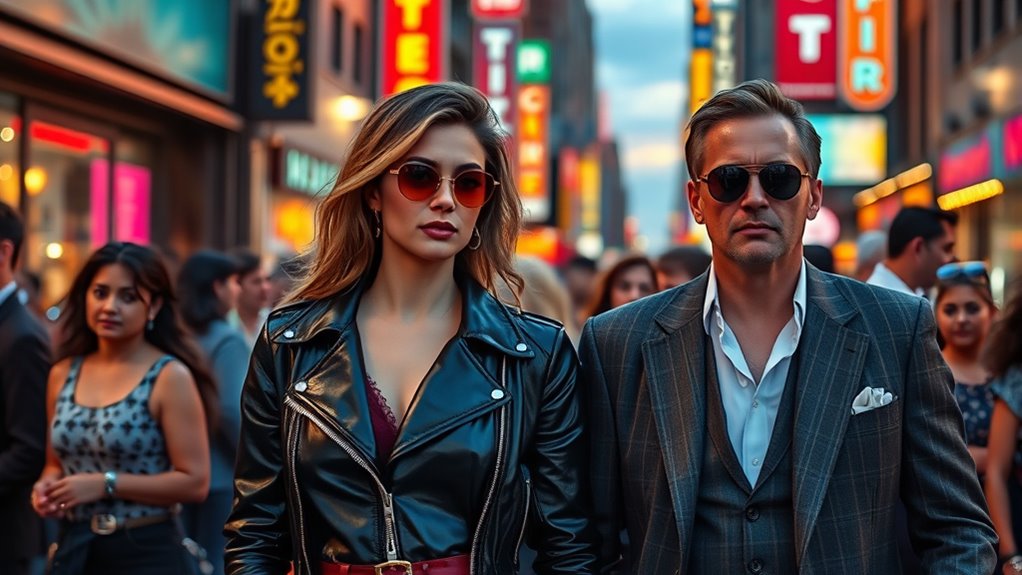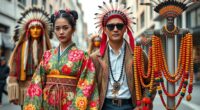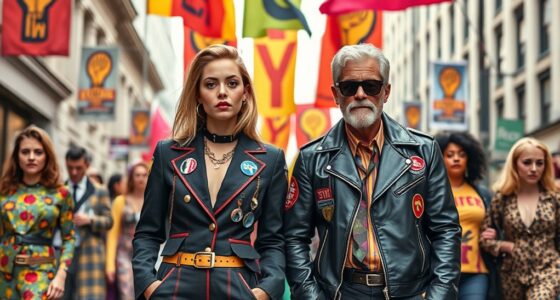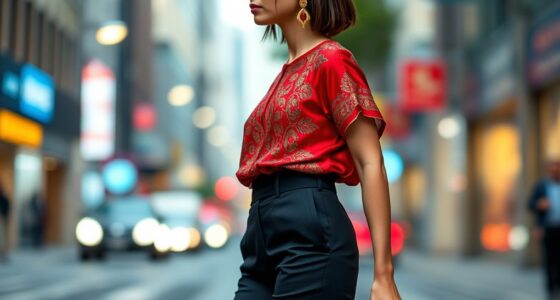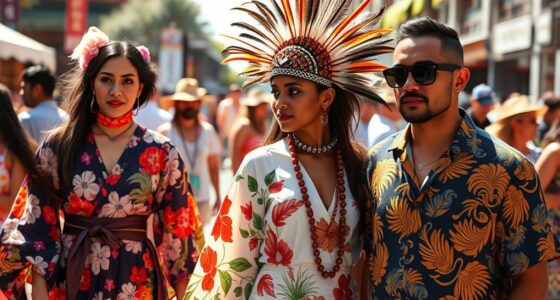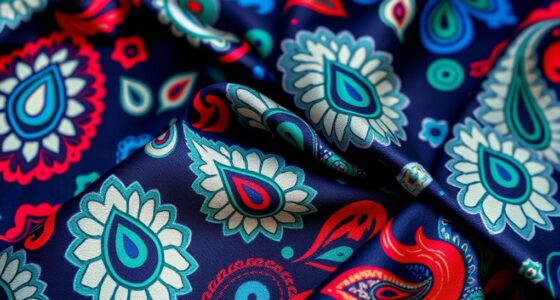Movies and TV shapes your fashion choices by creating iconic styles that become trends, inspiring you to try new looks. Celebrity endorsements and memorable characters often set the tone for what’s fashionable, turning fictional wardrobes into real-world inspirations. As costumes and styles evolve on screen, they influence everything from streetwear to designer collections. If you want to discover how these entertainment influences have shaped fashion over time, keep exploring the fascinating connection between media and style.
Key Takeaways
- Iconic costumes in movies and TV shape popular fashion trends and inspire real-world clothing choices.
- Celebrity endorsements and character styles influence consumer behavior and set new style standards.
- Media-driven visual storytelling creates memorable looks that become cultural symbols and fashion blueprints.
- The influence of specific eras and costume designs in media sparks retro revivals and innovative fashion ideas.
- Retailers and brands capitalize on on-screen fashion, driving sales through themed collections and celebrity collaborations.
The Birth of Iconic Costumes and Their Cultural Impact
Many iconic costumes in movies and TV shows have shaped fashion trends and cultural identities. When you see a character don a distinctive outfit, it often sparks a new style craze or redefines what’s fashionable. Think of Superman’s cape or Princess Leia’s buns—they became symbols beyond their stories, influencing clothing choices worldwide. These costumes do more than entertain; they reflect societal values, aspirations, and identity. As you observe these designs, you realize they often push boundaries or reinforce stereotypes, shaping public perceptions. Over time, such costumes transcend entertainment, becoming cultural touchstones that inspire designers, fans, and entire movements. They’re not just wardrobe choices but powerful symbols that embed themselves into our collective consciousness, leaving a lasting impact on fashion and culture. Additionally, the costumes’ materials and craftsmanship often influence fashion designers seeking to replicate or reinterpret these iconic looks. Moreover, understanding the origins and cultural significance behind these costumes helps us appreciate their enduring influence.
Celebrity Endorsements and On-Screen Style Inspiration
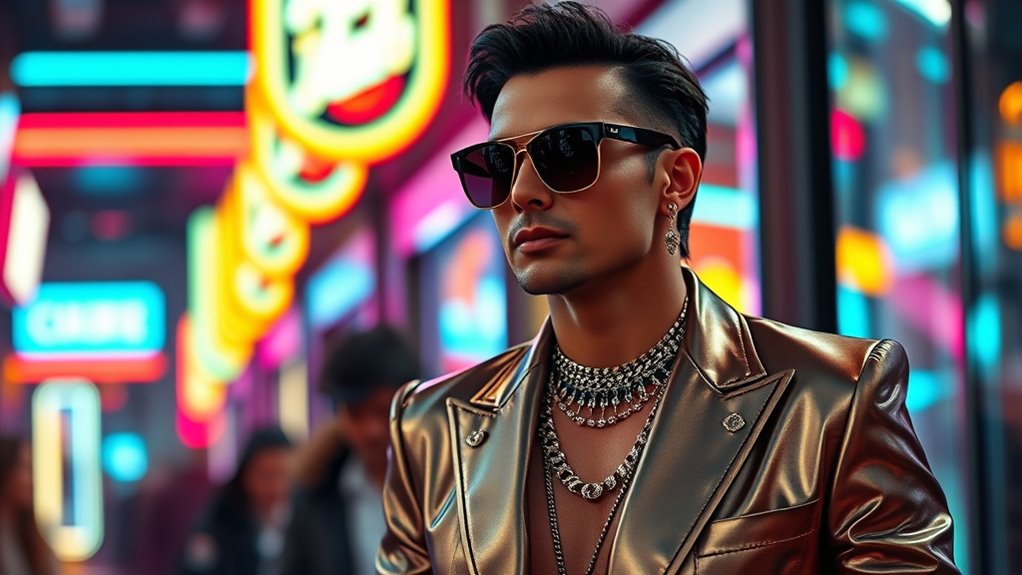
Celebrity endorsements and on-screen style moments have a powerful influence on fashion trends, shaping what you want to wear and how you see yourself. When a favorite star sports a designer outfit or a signature accessory, it sparks your desire to emulate their look. Movies and TV shows showcase styles that quickly become desirable, turning fictional characters into style icons. Brands often leverage this influence, partnering with celebrities to endorse products that instantly gain popularity. You might find yourself shopping for similar pieces after seeing them on screen or worn by a celebrity you admire. These endorsements create a sense of aspiration, making fashion feel accessible and personal. Additionally, fashion trends are often driven by the diverse styles seen in media, reflecting and influencing cultural preferences in real time. The role of media in shaping fashion is further amplified by the visual appeal of on-screen wardrobes, which can set new standards for beauty and style. Moreover, the visual storytelling in movies and TV can highlight specific fashion statements, making them memorable and influential in the broader fashion landscape.
The Rise of Fashion Trends Through Film and Television Eras
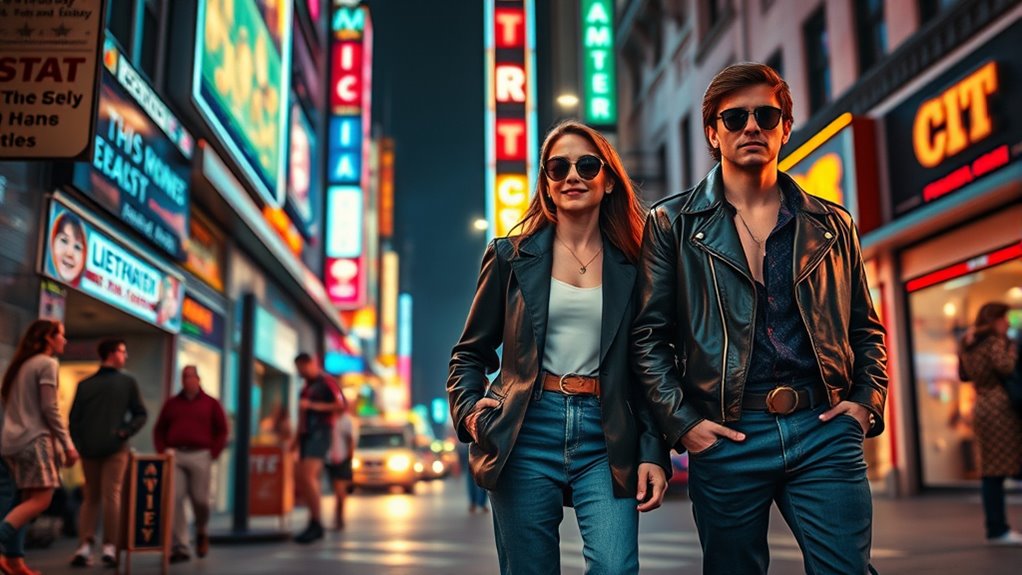
You’ve probably noticed how Hollywood has sparked major style changes over the years. Iconic costume moments on screen often set new trends that fans enthusiastic imitate. Plus, TV shows today continue to shape what’s fashionable and how people express themselves. For example, costume inspirations like superhero outfits or themed dress-up ideas often influence real-world fashion choices, bridging entertainment and personal style. Additionally, Halloween costume trends and themed accessories like capes and tiaras are frequently inspired by popular media characters. Recognizing the influence of media-driven fashion helps us understand how entertainment continues to shape personal style choices across diverse audiences. The integration of fashion trends from movies and TV demonstrates how media can directly impact clothing styles and accessories in everyday life, especially as costume styles evolve with innovative planters that showcase creativity in home decor.
Hollywood’s Style Revolution
How did Hollywood movies and TV shows become powerful engines for shaping fashion trends? It all started with iconic actors and characters whose styles resonated with audiences. When celebrities donned a particular look, it quickly caught on, influencing what people bought and wore. During the Golden Age of Hollywood, stars like Audrey Hepburn and Marilyn Monroe set timeless trends that defined entire eras. As television grew, it brought fashion closer to home, making celebrity styles accessible. Shows like “Mad Men” revived mid-century elegance, while modern series continue to popularize bold, unique looks. Hollywood’s influence extends beyond clothing—shaping beauty standards, accessories, and grooming. Additionally, the integration of authentic fashion choices in media has helped solidify trends, making them more relatable and desirable. This ongoing cycle is further strengthened by the use of costume design and styling to create memorable characters that leave lasting impressions. Incorporating visual storytelling through wardrobe choices enhances the cultural impact of fashion in media. It’s a constant cycle where screen style inspires real-world fashion, transforming trends into cultural phenomena, especially with the rise of social media platforms amplifying celebrity influence and fashion-inspired content.
Iconic Costume Moments
Iconic costume moments in film and television have solidified their place as powerful catalysts for fashion trends. When you see characters like Audrey Hepburn in *Breakfast at Tiffany’s* or James Bond’s sharp suits, you instantly recognize how these looks influence real-world style. These moments don’t just entertain—they set standards and spark new trends. Think of Carrie Bradshaw’s bold tutu or Michael Jackson’s sequined glove; they turn into must-have items and style icons. Such costumes become timeless symbols, inspiring designers and shaping seasons of fashion. Additionally, the integration of automation technologies in the fashion industry has facilitated rapid production and distribution of trending styles, further amplifying their influence. You may find yourself shopping for a little black dress or trying to replicate a signature look. These costume moments create a lasting impact, proving that what you wear on screen can transform everyday fashion and influence cultural perceptions of style.
TV’s Trend-Setting Power
Television has become a powerful force in shaping fashion trends, often turning characters’ distinctive styles into widespread cultural phenomena. When you watch a popular show, you might notice how a character’s wardrobe sparks new trends. Think of these key moments:
- A character’s signature look inspires streetwear or designer collections.
- TV shows popularize specific accessories, like statement jewelry or hats.
- Fashion brands often collaborate with TV series to create exclusive lines based on on-screen styles.
- The influence of television on fashion is amplified when viewers develop cultural intelligence to interpret and incorporate diverse styles into their own wardrobes.
Additionally, the trend-setting power of TV enables viewers to adapt styles from different eras and cultures, broadening their fashion horizons. This dynamic is further supported by the merchandising strategies that extend a show’s fashion influence beyond the screen, encouraging consumer engagement. These strategies make it clear that TV doesn’t just entertain—it influences what everyone wears. Your favorite characters can set the tone for upcoming fashion seasons, turning fictional styles into real-world trends. If a character wears a bold jacket or vintage accessories, you’re more likely to see those items in stores soon after, especially as viewers become more attuned to fashion influence through television. Moreover, the impact of visual storytelling helps solidify iconic looks that resonate across generations.
How Characters’ Wardrobes Spark Consumer Fashions
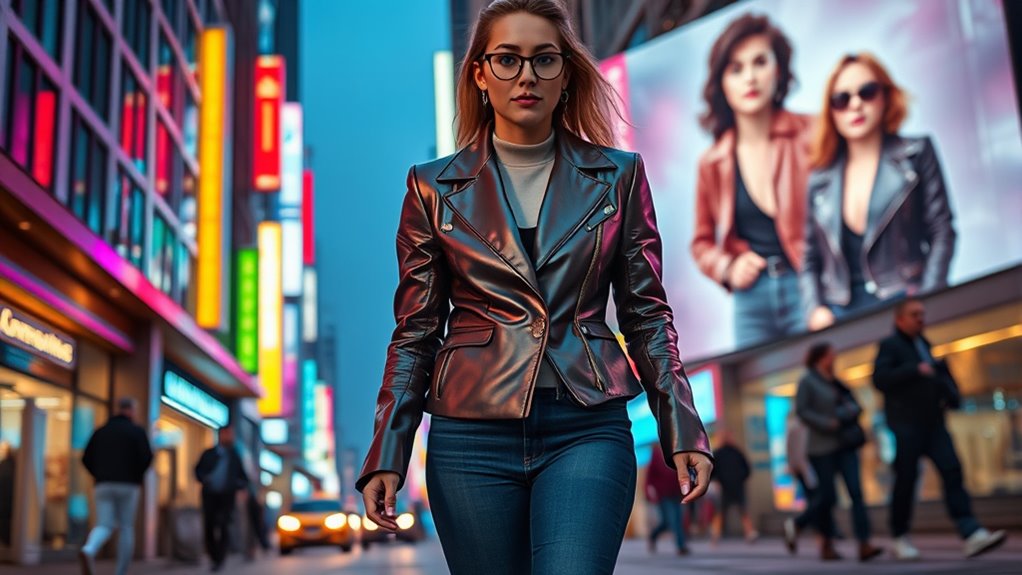
When characters in movies and TV shows wear striking outfits, they often become unexpected trendsetters. You might notice that after seeing a character in a bold jacket or iconic shoes, many people rush to copy the look. These wardrobes influence consumer behavior, sparking demand for similar styles. Brands quickly take note, releasing products inspired by popular characters to capitalize on the trend. Sometimes, a character’s distinctive style even causes a specific clothing item or accessory to become a must-have. As viewers, you’re drawn to replicate what you see on screen, fueling sales and shaping broader fashion preferences. This cycle shows how a character’s wardrobe isn’t just costume; it’s a powerful catalyst that ignites real-world consumer fashion trends. Incorporating trending genres and market research can help predict which styles will resonate with audiences next. Additionally, the influence of media exposure extends beyond entertainment, shaping public perceptions of style and desirability. The impact of popular character styles can also lead to the revival of vintage and classic fashion elements, further influencing consumer choices.
The Role of Costume Design in Setting Fashion Movements
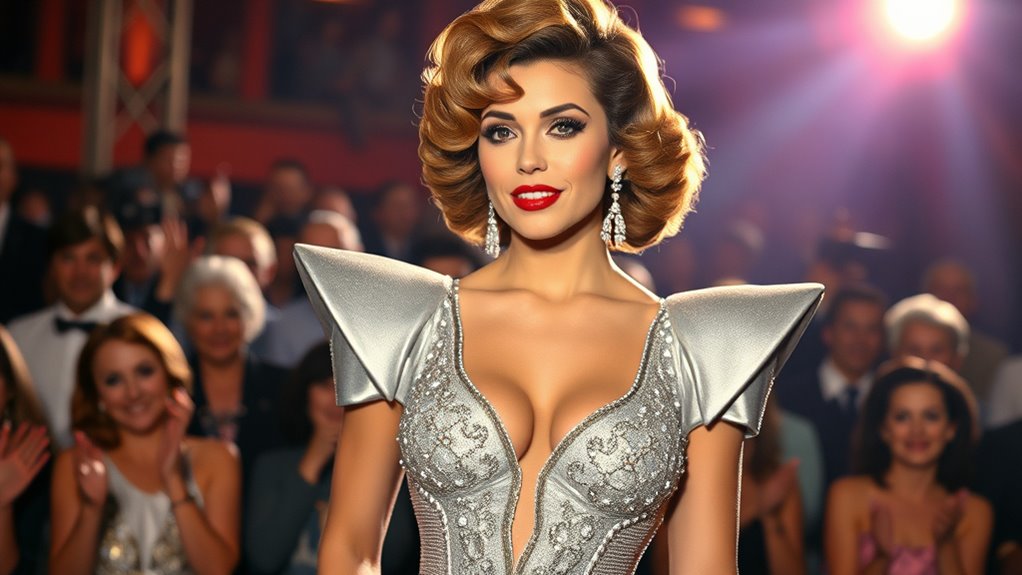
Costume design plays a pivotal role in shaping fashion movements by transforming screen characters into style icons. When designers craft iconic looks, they influence real-world trends and inspire clothing choices. Think about how a character’s signature wardrobe sparks new styles or revives retro fashion. Additionally, the use of Indonesian decor masks in media can introduce audiences to diverse cultural aesthetics, subtly influencing fashion preferences. Here are three ways costume design sets fashion movements: 1. Creating timeless looks that become instantly recognizable and sought after. 2. Introducing innovative materials and silhouettes** that challenge traditional fashion norms. 3. Reflecting cultural shifts** by incorporating diverse styles, making trends more inclusive. Recognizing the impact of media influence helps explain how popular characters’ outfits often serve as blueprints for fashionable trends, turning screen styles into everyday must-haves. Moreover, understanding costume design techniques can reveal how designers craft looks that resonate deeply with audiences and leave a lasting impression. Incorporating fashion history into costume design can further inspire designers to create authentic and enduring styles. Costume design doesn’t just dress characters—it shapes what becomes fashionable across the world. Understanding the importance of fashion influence helps appreciate how media shapes our clothing choices.
From Screen to Street: The Commercial Power of Movie and TV Fashion
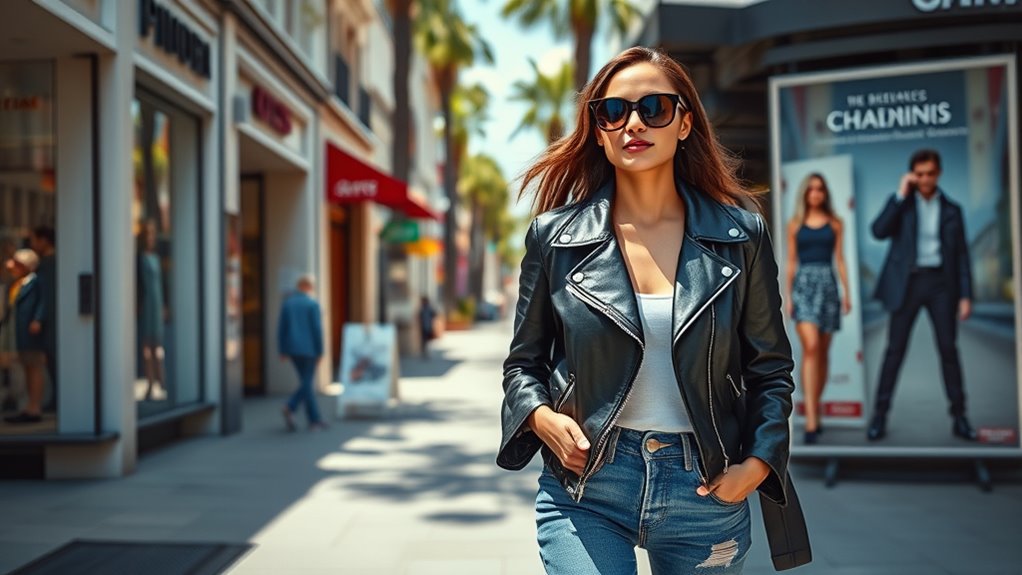
Movies and TV shows have a powerful ability to turn fashionable looks into mainstream trends that drive global commerce. When you see a character wearing a stylish jacket or iconic shoes, it often sparks a surge in sales as fans want to emulate their favorite characters. Retailers quickly capitalize on this demand by releasing similar styles, turning screen fashion into must-have items. Brands often partner with filmmakers or TV producers to feature their products, knowing it boosts visibility and sales. This phenomenon transforms fictional wardrobes into real-world market opportunities, creating a cycle where on-screen fashion influences consumer behavior. As a viewer, you might find yourself enthusiastic to purchase what you see on screen, fueling the commercial power of movie and TV fashion beyond the screen.
The Influence of Fashion Icons Created by Visual Storytelling

Visual storytelling has the power to elevate characters into cultural icons, shaping how you perceive style and beauty. When filmmakers craft memorable characters, their fashion choices become influential symbols. Think of the iconic looks that resonate long after the credits roll. These characters inspire trends and set new standards in fashion. To understand this influence, consider:
- How a character’s signature outfit sparks new clothing styles in stores.
- The way celebrity endorsements emerge from iconic TV characters’ wardrobe choices.
- How fashion brands replicate or adapt these styles to appeal to fans and consumers alike.
Frequently Asked Questions
How Do Costume Designers Choose Styles That Become Fashion Trends?
When choosing styles that become fashion trends, costume designers consider current cultural influences, story context, and character personality. You’ll notice they often select bold, memorable pieces that resonate emotionally and visually. By mixing timeless elements with modern twists, they create looks that viewers connect with deeply. As a result, these styles catch on quickly, inspiring everyday fashion and shaping trends long after the credits roll.
What Role Does Social Media Play in Amplifying TV and Movie Fashion Influence?
Think of social media as a giant megaphone, amplifying the fashion voices from your favorite TV shows and movies. When you share a stylish look, tag an actor, or post a trend-inspired outfit, you become part of a dynamic echo chamber. This rapid spread transforms fleeting on-screen styles into everyday wardrobe staples, turning viewers into trendsetters and making fashion influence feel like an unstoppable wave crashing right into your closet.
How Quickly Do Fashion Trends From Screen Appearances Usually Translate Into Mainstream Culture?
Fashion trends from screen appearances often spread rapidly into mainstream culture, sometimes within days or weeks. When you see a celebrity or character sporting a new style, you’re likely to notice shops and online stores quickly offering similar items. Social media accelerates this process, allowing trends to go viral almost instantly. So, if you love a look on screen, expect it to influence your wardrobe sooner than you think.
Can Fictional Characters’ Wardrobes Lead to Lasting Fashion Movements?
Did you know that nearly 60% of people say they’ve bought clothes inspired by a fictional character? When you see a character’s wardrobe, it can spark a genuine fashion movement if it resonates. Your favorite character’s style can influence trends for years, especially if it’s adopted by influencers and designers. So yes, wardrobes of fictional characters can definitely lead to lasting fashion movements that shape mainstream culture.
What Psychological Factors Make Viewers Emulate Onscreen Fashion Choices?
You’re often influenced by onscreen fashion choices because they tap into your desire for social acceptance and admiration. When you see favorite characters wearing stylish outfits, you may feel inspired to emulate them to feel connected or confident. Additionally, your brain responds positively to visual cues and storytelling, making you more likely to adopt these looks as a way to express your identity and align with admired trends.
Conclusion
You see, movies and TV shows are like a mirror reflecting and shaping your fashion choices. They inspire you just as a brushstroke inspires a masterpiece, turning on-screen style into everyday trends. When characters wear iconic outfits, it’s as if they plant seed in your mind, growing into new fashion habits. So, next time you dress, remember: your look is part of this powerful, cinematic dance shaping the world of fashion.
